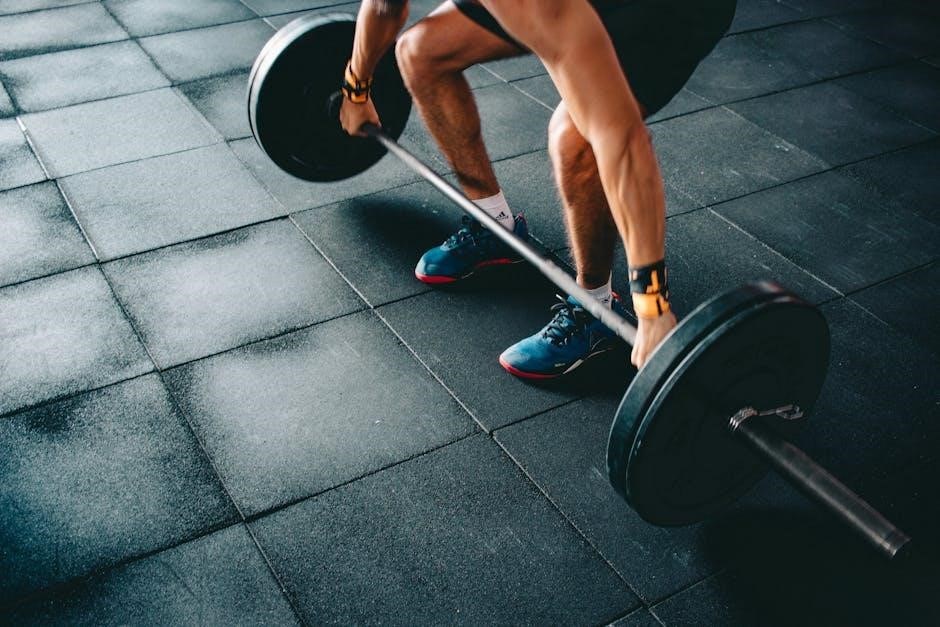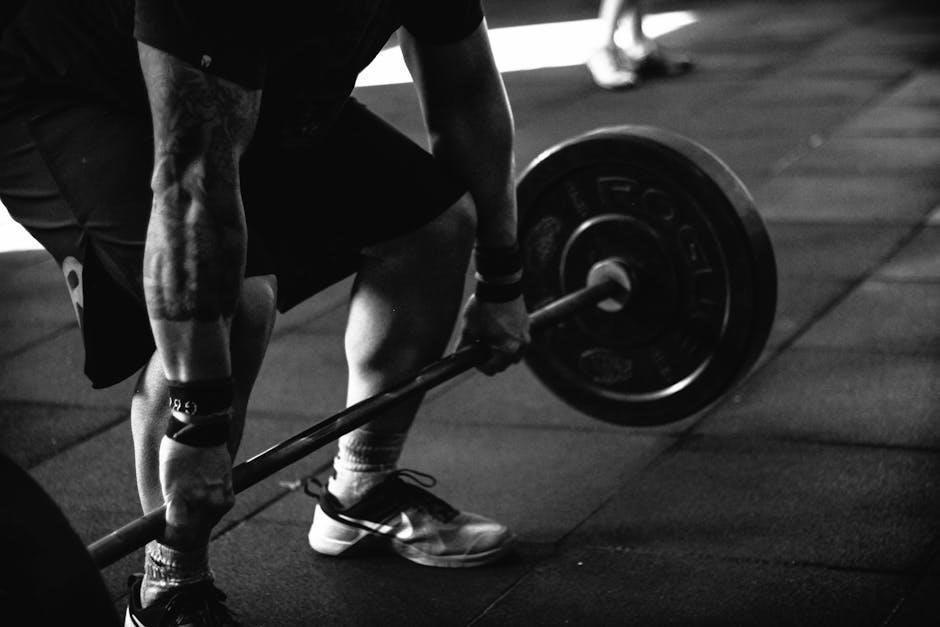proper lifting techniques pdf

Proper Lifting Techniques: A Comprehensive Guide
This comprehensive guide unveils essential proper lifting techniques for preventing back and lifting-related injuries at work and home․ By understanding these principles, you enhance workplace safety, minimize risks, and foster health․ Discover practical tips for effective lifting strategies!
Welcome! This section introduces proper lifting techniques, a cornerstone of workplace safety․ Proper lifting is not merely about moving objects; it’s about safeguarding your body from potential harm․ These techniques are applicable in various settings, from industrial environments to everyday tasks at home, ensuring a consistent approach to safety․ It is imperative to understand proper lifting techniques to protect yourself from unnecessary strain and injury․
This introduction sets the stage for a deeper dive into the importance, risks, and practical application of these techniques․ By mastering the fundamentals, you can significantly reduce the likelihood of musculoskeletal disorders, particularly back injuries, which are prevalent in many industries․ As such, we will explore the essential aspects of proper lifting techniques, the associated risks, best practices, and relevant Regulations․
Remember, safety is paramount․ Proper lifting techniques are essential for health and safety success in any workplace․ Learn essential proper lifting techniques to enhance workplace safety and discover practical tips for injury prevention․
Importance of Proper Lifting Techniques
Understanding the importance of proper lifting techniques is paramount for maintaining a safe and healthy environment․ These techniques are not merely suggestions; they are essential practices that significantly reduce the risk of musculoskeletal injuries, particularly back injuries, which are a leading cause of workplace disability․ By adhering to proper lifting methods, individuals can protect themselves from unnecessary strain and long-term health issues․
Proper lifting techniques promote better posture and body mechanics, minimizing the stress on joints and muscles․ This leads to increased comfort and productivity, as employees are less likely to experience fatigue and discomfort during their tasks․ Moreover, these techniques can help prevent cumulative trauma disorders that develop over time due to repetitive or awkward movements․
Ultimately, understanding the importance of these techniques contributes to a safer, healthier, and more productive workforce․ Use this guide to prevent back and lifting-related injuries and implement safe lifting practices to help your employees avoid injuries․
Risks Associated with Improper Lifting
Improper lifting techniques pose significant risks to physical health and well-being․ One of the most common consequences is back injury, ranging from muscle strains to herniated discs․ These injuries can result in chronic pain, reduced mobility, and the need for extensive medical treatment․ Ignoring proper form while lifting places excessive stress on the spine, increasing the likelihood of these debilitating conditions․
Furthermore, improper lifting can lead to injuries in other parts of the body, such as shoulders, knees, and hips․ These joints are vulnerable when the body is not properly aligned and the weight is unevenly distributed․ Sprains, strains, and tears can occur, leading to discomfort and restricted movement․ Repetitive improper lifting can also contribute to cumulative trauma disorders like carpal tunnel syndrome․
In addition to physical injuries, improper lifting can have broader implications, including decreased productivity, increased absenteeism, and higher healthcare costs for both individuals and employers․ By understanding and mitigating these risks, individuals can protect their health and well-being, while organizations can create a safer and more efficient work environment․
Preparation and Planning for Lifting
Before initiating any lifting task, thorough preparation and planning are crucial for ensuring safety and preventing injuries․ Start by evaluating the load’s weight and size to determine if it is manageable alone or requires assistance․ If the object seems too heavy or awkward, seek help or utilize mechanical aids․
Next, assess the environment for potential hazards․ Clear the path of any obstacles that could cause tripping or stumbling․ Ensure adequate lighting to provide clear visibility of the lifting area․ Consider the distance the object needs to be moved and plan the route accordingly․
Proper posture and body mechanics begin before the lift․ Warm-up stretches can help prepare muscles and joints for the task․ Position yourself close to the object, ensuring a stable base with feet shoulder-width apart․ Visualize the lifting process, focusing on maintaining a straight back, bending at the knees and hips, and keeping the load close to the body․ This proactive approach minimizes the risk of strain and injury during the lift․

Step-by-Step Guide to Correct Lifting Technique
Mastering the correct lifting technique is paramount for injury prevention․ Start by positioning yourself close to the load, feet shoulder-width apart for a stable base․ Bend at your knees and hips, keeping your back straight, avoiding any twisting motions․ Secure a firm grip on the object, ensuring your hands are positioned for optimal control․
As you lift, engage your leg muscles, keeping your back straight and the load close to your body․ Lift smoothly, avoiding jerky movements, and maintain a neutral spine throughout the lift․ Breathe out during the exertion phase․ Once standing, keep the object close to your waist for as long as possible․
To lower the object, reverse the steps, bending at your knees and hips while maintaining a straight back․ Place the object down gently, avoiding any sudden drops․ Remember to keep your nose between your toes, preventing any twisting or turning of the torso․ By consistently following these steps, you can minimize the risk of strain and promote safe lifting practices․
Dos and Don’ts of Lifting
When it comes to lifting, adhering to a set of dos and don’ts is crucial for preventing injuries․ Do plan your lift before you start, assessing the weight and stability of the object․ Do position your feet shoulder-width apart for a stable base․ Do bend your knees and keep your back straight, using your leg muscles to lift․ Do keep the load close to your body to minimize strain on your back․ Do get help if the object is too heavy or awkward to lift alone․
Conversely, there are several actions you should don’t do․ Don’t lift with a bent back or twist your torso while lifting․ Don’t lift objects that are too heavy for you․ Don’t reach far away from your body to grab an object․ Don’t lift quickly or jerkily, as this can strain your muscles․ Don’t ignore pain or discomfort while lifting; stop immediately and seek assistance․ By following these guidelines, you can significantly reduce the risk of lifting-related injuries․
Using Lifting Aids and Ergonomic Equipment
Lifting aids and ergonomic equipment play a vital role in reducing the risk of injuries associated with manual handling․ These tools are designed to assist in lifting, moving, and positioning objects, minimizing strain on the body․ Lifting aids such as dollies, hand trucks, and forklifts can significantly reduce the physical demands of moving heavy loads․ Ergonomic equipment, including adjustable workstations, lifting tables, and specialized tools, can help to optimize posture and reduce repetitive motions․
When selecting and using lifting aids and ergonomic equipment, it’s essential to consider the specific task and the individual’s capabilities․ Proper training is crucial to ensure that employees know how to use the equipment safely and effectively․ Regular maintenance and inspection of lifting aids and ergonomic equipment are also necessary to prevent malfunctions and ensure their continued effectiveness․ By incorporating these tools into the workplace, employers can create a safer and more comfortable environment for their employees, reducing the risk of musculoskeletal disorders and other lifting-related injuries․ Remember to always use equipment correctly․

Training and Education for Employees
Comprehensive training and education programs are paramount for equipping employees with the knowledge and skills necessary to perform manual handling tasks safely and effectively․ These programs should cover a wide range of topics, including proper lifting techniques, ergonomic principles, and the use of lifting aids and ergonomic equipment․ Employees should learn how to assess the weight and stability of loads, plan their lifts, and use proper body mechanics to minimize strain on their backs and other muscles․ Training should also emphasize the importance of teamwork and communication when lifting heavy or awkward objects․
In addition to initial training, ongoing education and refresher courses are essential to reinforce safe lifting practices and keep employees up-to-date on the latest techniques and equipment․ These programs should be interactive and engaging, incorporating hands-on exercises and real-world scenarios to enhance learning and retention; By investing in thorough training and education, employers can empower their employees to take an active role in preventing lifting-related injuries and creating a safer work environment․ Make sure all team members are trained․
Reporting Ergonomic Hazards and Injuries

Establishing a robust system for reporting ergonomic hazards and injuries is crucial for maintaining a safe and healthy work environment․ Employees should be encouraged to report any potential hazards they identify, such as improperly designed workstations, inadequate lifting equipment, or unsafe work practices․ A clear and confidential reporting process should be in place, allowing employees to raise concerns without fear of reprisal․ All reports should be promptly investigated, and appropriate corrective actions should be taken to eliminate or mitigate the identified hazards․ Furthermore, employees should be encouraged to report any musculoskeletal discomfort or injuries they experience, no matter how minor they may seem․
Early reporting of symptoms can help prevent more serious injuries from developing․ The reporting system should include a mechanism for tracking and analyzing injury data to identify trends and patterns․ This information can be used to develop targeted interventions and improve the effectiveness of ergonomic programs․ By fostering a culture of open communication and proactive reporting, organizations can create a safer and more supportive work environment for all employees․ Encourage Reporting: Create a system for workers to report ergonomic hazards or injuries․ Use clear communication during the lifting process․
Safe Lifting Practices at Work and Home
Safe lifting practices are essential both at work and at home to prevent injuries․ Before lifting anything, assess the weight and size of the object․ If it’s too heavy or awkward, seek assistance or use lifting aids․ Plan your lift, ensuring a clear path and stable footing․ Position yourself close to the object, maintaining a wide base of support․ Bend your knees and keep your back straight, using your leg muscles to lift․ Avoid twisting or jerking motions, and keep the object close to your body throughout the lift․ When setting the object down, reverse the process, using your legs to lower it gently․

At work, ensure proper training on lifting techniques and the availability of ergonomic equipment․ Regularly inspect lifting aids for damage and report any concerns․ At home, be mindful of lifting heavy items, especially when gardening, moving furniture, or carrying groceries․ Encourage family members to follow safe lifting practices and provide assistance when needed․ By implementing these practices, you can minimize the risk of injuries․ These guidelines should be used when lifting or moving ANY loads, both at work and at home․ Whenever possible, make use of material-handling equipment such as dollies․
Regulations and Guidelines for Safe Lifting
Adhering to regulations and guidelines for safe lifting is crucial for maintaining a safe work environment and preventing injuries․ Organizations like OSHA (Occupational Safety and Health Administration) provide comprehensive guidelines on manual handling and lifting techniques․ These guidelines outline acceptable weight limits, proper lifting procedures, and the use of lifting aids․ Employers are responsible for providing training to employees on these regulations and ensuring compliance․
Regulations often specify the maximum weight an individual can lift without assistance, considering factors like the distance of the load from the body and the frequency of lifting․ Guidelines emphasize the importance of assessing the load, planning the lift, and using proper body mechanics․ They also highlight the need for ergonomic assessments to identify and mitigate potential hazards․ Additionally, guidelines encourage the use of mechanical aids like forklifts, cranes, and dollies to reduce the risk of manual handling injuries․
Regularly reviewing and updating safety protocols based on these regulations is essential․ Implementing a system for reporting ergonomic hazards and injuries is also vital for continuous improvement․ Staying informed about the latest regulations and guidelines ensures a proactive approach to safe lifting practices․